#fioretta gorini
Text

"The mother of Pope Clement VII remains an enigmatic figure. Pieraccini cites a record of the Pazzi conspriacy by Antonio da San Gallo in which he wrote that Giuliano had a son, aged one, by the time he was killed in the Pazzi conspiracy in 1478. The mother was ' a woman of the Gorini, his friend. The said Lorenzo went to see him and then gave him to the care of the same Antonio, where he stayed until his seventh year. The said son had the name of Giulio and was born on the 6th March 1478. Seraccini is cited as stating that she was Fioretta di Antonio di Michele di Iacopo del Ciptadino corazzaio. Pieraccini however states that the mother's name was certainly 'Fioretta', but that all else is unknown.
An unpleasant paragraph then follows outlining the importance of knowing who the mother was, owing: ' on the laws of hereditary biology, the knowledge of whether Fioretta was daughter of nobles or plebs must be important, for example, to recognise the inheritance of particular refined talents or dispositions, presumably more developed in the Florentine upper classes than in the lower ones.' Giulio had himself declared legitimate during Giovanni's cardinalate, saying that his mother had been secretly married to Giuliano. The eighteenth-century Jesuit antiquarian, Giuseppe Richa, in an attempt to ensure the Medici pope's legitimacy to the throne of S. Peter, repeated this claim of a secret marriage. Hibbert follows the Gorini reference, and identifies her as Fioretta Gorini. 'This boy, whose mother soon afterwards died, was adopted by Lorenzo'. Young identifies her as Antonia Gorini." - Women on the margins: the beloved and the mistress in Renaissance Florence
#perioddramaedit#donneitaliane#donne italiane#donne nella storia#donne della storia#fioretta gorini#giuliano de medici#medici#mediciedit#imedici#miriam leone#Giulio de medici#antonia gorini#historical figures#history#historyedit#women of history#women in history#renaissance women#rinascimento#15th century#italiansedit#italian history#italian renaissance#women's history#women of renaissance#perioddramasource#period drama#perioddramacentral#historicwomendaily
57 notes
·
View notes
Photo

Book of the Day, October 26th -- C/T/M/H
Temporarily FREE:https://forums.onlinebookclub.org/shelves/book.php?id=331084
The Girl Who Knew Da Vinci: (Out of Time Thriller, #1) by Belle Ami
---------
This book is temporarily available free on Kindle. You do not need a Kindle to read it. You can read the free Kindle book on any smartphone tablet or computer!
This book is a previous Book of the Month! You can view the discussion here: https://forums.onlinebookclub.org/viewforum.php?f=155
---------
Art historian Angela Renatus is haunted by dreams of Leonardo da Vinci and a mysterious painting of Giuliano Medici and his mistress Fioretta Gorini. A painting that, as far as the world knows, doesn't exist. Compelled by her visions, Angela is determined to find out the truth.
Three destinies, three timeless loves, one remarkable painting.
Will her visions lead her to the truth?"Readers who enjoy a juicy plot and a blend of genres should add this book to their reading list. Art lovers will certainly appreciate the subject matter. You will lose track of time and find yourself reading well into the night." ~ OBC reviewer, bookowlie
----------
https://forums.onlinebookclub.org/shelves/book.php?id=331084
2 notes
·
View notes
Photo

Fioretta Gorini (1453/60 – possibly 1478) was the mistress of Giuliano de' Medici and the mother of Giulio de' Medici, the future Pope Clement VII. Gorini was the daughter of a professor, Antonio Gorini. Her actual name was Antonia or Antonietta, while Fioretta was a nickname given to her.
On May 26, 1478, a month after the assassination of Giuliano in the Pazzi conspiracy, Fioretta gave birth to his illegitimate son, Giulio. Not much of Gorini's life after her son's birth is known, and some records have her dying that same year. Giulio spent the first seven years of life with his godfather, architect Antonio da Sangallo the Elder.
The female figure of Fioretta may be represented in Ritratto di giovane donna (1475), of Sandro Botticelli, which is preserved in Palazzo Pitti, although it may equally represent Simonetta Vespucci, Clarice Orsini, Alfonsina Orsini or Lucrezia Tornabuoni. The woman sculpted on Dama col mazzolino (1475), of Andrea del Verrocchio, which is preserved in Museo Nazionale del Bargello, could be Fioretta Gorini. There has also been speculation that Gorini was the inspiration behind the Mona Lisa.
21 notes
·
View notes
Text
please help me out, would i use her for rosa ( aka mistress of lorenzo the elder ) or fioretta gorini ( aka mistress of giuliano de medici / mother of giulio de medici ) :






2 notes
·
View notes
Text
name : giulio de’medici
parents : father : giuliano de’medici & mother : fioretta gorini
age : verse dependant
siblings : none
guardians : lorenzo de’medici ( uncle ) & clarice orsinid ( aunt )
sexuality : bisexual
fc : ruairi o'connor
appearance // giulio resembles his mother more than he does his father , appearance. he has her reddish hair , her eyes , her nose but giulio’s jaw and bone structure. he is built much like his father however , and is as tall as his uncle lorenzo , one he reaches adulthood.
early life // ( this will be more show based ) giulo struggled to adapt to being raised within the medici palazzo. he missed his mother greatly and despite the kindess of lorenzo and clarice , he felt more on the outside than the inside. he sensed piero’s dislike almost immediately and that formed a gap between them. it was lorenzo telling him stories of his father that made him feel a little more comfortable , in time he began to trust his uncle and soon developed an interest in art , philosphy and music and he began to show a high amount of intelligence. with time he formed a rather strong relationship with giovanni and they became very close , like brothers.
during his childhood , he became interested in religion , learning from his aunt and admiring her for her devotion. he loved her like a mother but he never forgot his own who died to protect him. his mother was ever present at the forefront of his mind as he was growing up & he constantly hungered for revenge.
( giulio does go on to become a cardinal and then a pope & i do follow medici’s storyline regarding that but there are some changes because..yeah. I also have a verse where he does not become cardinal nor pope but instead pursues a life in the arts )
personality // he has his fathers quick temper , it does not take much to aggravate giulo , but he also has his mothers soft heart ( and from his uncle he learned the art of diplomacy and how that can be more effective than a sword ). giulio cares very deeply for those around him. he grows attached quite easily , some might say it is because of the violent way he lost his mother. giulio loves extremely deeply , so much so that it can be hard for him when relationships end. like his father , he has a habit of punishing himself for things out of his control - he also struggles to open up and can come across as withdrawn when he is upset about something. he is not the kind to confide in others. giulo is very bright and has no problem showing it either. he has been known to correct people when they are wrong , regardless of if it might cause offense. he revels in learning and knowing. Giulo can be extremely stubborn , he’s bullheaded and when in an argument will not back down - his heart might be soft but his spine is made of steel. He’s courageous but he’s also foolhardy ( like Giuliano ).
#( giulio de'medici // about )#anyway i took a lot of liberties here but#-shrugs-#i always do with my medici muses so#i wanted him to be seen in a specific way which is why i've written his thing up#i might do the others idk#and yes he's bisexual bc again i do what i want
1 note
·
View note
Text
I need people who have read the story of the Medici family, who understand and know that Giuliano de Medici never loved Simonetta Vespucci, his true “forbidden” love was called Fioretta Gorini, the mother of his son Giulio. Giuliano secretly married Fioretta (due to his different social class and the fact that his mother wouldn't accept it), she was the woman Giuliano really loved.
When Giuliano courted Simonetta in the tournament, they used this fact to start the rumors of a possible romance between them, (we all know what the “womanizer” Giuliano was). Simonetta loved her husband Marco Vespucci. But at that time they wanted to dirty the Medici surname, that's why these stories were invented.
It's a pity that the producers of I Medici have stayed with this version of the story and have not taken the trouble to investigate further. I hope they do not ruin Giulio's story in season 3
#merlin#arthur pendragon#i medici#lorenzo the magnificent#simonetta vespucci#i medici 2#medici the magnificent#bradley james#daniel sharman#giuliano de medici#tv: medici masters of florence
75 notes
·
View notes
Text
Giuliano mentioned rekindling an old flame which makes me think they might be hinting at Fioretta Gorini (who i WISH they cast in this show and made a deal of instead of Simonetta in relation to Giuliano cause like unless they were gonna do Simonetta right they coulda left her out or given her a tiny role and preserved her ~mystique~ a bit) and his child with her who went onto become Clement VII
sooooo given the fact that Bradley and Toby are both fair-haired and delicate featured and factoring in how Lorenzo basically raised Clement VII as his own maaaaaaaaaaybe Toby is playing Clement VII as a young man???
or he’s playing Piero and Piero just came out looking like his uncle to torture Lorenzo even more with how lazy and bad @ everything Piero is lol
#imagine lorezno going to clarice one night like 'hey if you say yes it's no big deal but you didn't like bone my brother right??'#'cause i can't believe that kid is mine...............'#mai watches medici masters
3 notes
·
View notes
Text
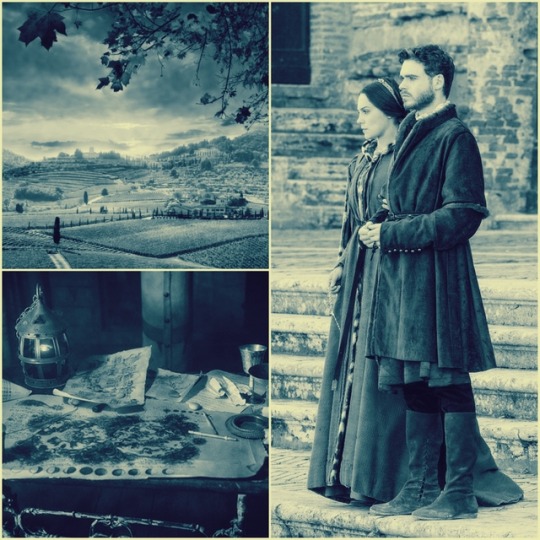
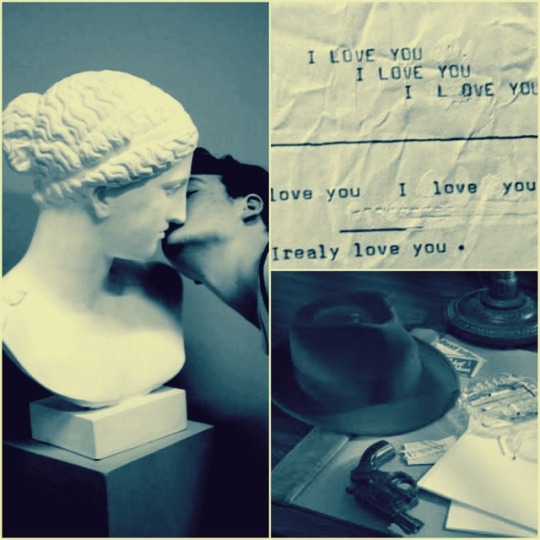
Read in 2018:
The Girl Who Knew Da Vinci by Belle Ami
"In the spirit of The Da Vinci Code by Dan Brown and the Art Forger by B.A. Shapiro . . . The Girl Who Knew Da Vinci by Belle Ami unravels an unforgettable mystery.
Three destinies, one remarkable painting.
Will her visions lead her to the truth?
Art historian Angela Renatus is haunted by dreams of Leonardo da Vinci and a mysterious painting of Giuliano Medici and his mistress Fioretta Gorini. A painting that, as far as the world knows, doesn't exist. Compelled by her visions, Angela is determined to find out the truth.
When Angela is contacted by art detective Alex Caine, she's shocked to learn that he too is seeking the same painting. Alex's client, a wealthy German financier, is determined to clear the name of his late uncle, Gerhard Jaeger, an art historian, who went missing in Florence, during World War II. In letters written before his disappearance, the historian describes his love affair with a beautiful young Italian woman named Sophia Caro and the discovery of an extraordinary painting by the great master himself-a painting depicting Giuliano and Fioretta.
Angela and Alex journey to Florence in search of the priceless treasure. Is it a lost da Vinci, potentially worth hundreds of millions of dollars, or a wild goose-chase that will only lead to a dead end? But someone else is searching for the elusive painting-Alberto Scordato is a powerful man in the art world and a sociopath who will stop at nothing to get what he wants, even murder. Scordato knows something about Angela that even she doesn't know, something that could threaten both Angela and Alex's lives, forcing them into the crosshairs of fate."
2 notes
·
View notes
Text
I always find it so funny when different (often respectable) sources give different titles to the same piece and then somewhere some academic is like NO THIS IS GINEVRA DEI BENCI and the some guy across the room is screaming ITS FIORETTA GORINI DAMN YOU
#letters from the authoress#i'm writing this scene about fioretta and i looked her up#and ofc there's no OFFICIAL portrait#but there are some presumed ones#but then there are people saying NOPE ITS NOT HER#so#the novel to be#sorta
16 notes
·
View notes
Photo

L’opera, forse la più nota di Sandro Botticelli, è databile intorno al 1482 e diverse fonti hanno confermato che il dipinto venne eseguito per Lorenzo di Pierfrancesco de’ Medici (1463-1503), cugino di secondo grado del Magnifico. La scena in un boschetto formato da alberi di arancio e frutti; sullo sfondo di un cielo azzurro, sono disposti nove personaggi, in una composizione che ruota attorno al personaggio centrale, una donna con drappo rosso. Il suolo è composto da un prato formato da una gran varietà di specie vegetali e di fiori. La Primavera nasconde vari livelli di lettura: uno strettamente mitologico, la cui spiegazione è ormai unanimamente condivisa; uno filosofico, legato principalmente alla filosofia dell’accademia neoplatonica; uno storico-dinastico, legato alle vicende contemporanee ed alla gratificazione del committente e della sua famiglia. Il senso complessivo dell’opera è ancora piuttosto oscuro e aperto alle più varie interpretazioni. Secondo l’interpretazione mitologica i personaggi si trovano nel famoso giardino delle Esperidi: il primo da destra è Zefiro, vento di primavera che rapisce per amore la ninfa Clori, mettendola incinta; da questo atto la ninfa rinasce e si trasforma in Flora, ovvero la stessa primavera rappresentata come una donna coperta da un abito fiorito e che sparge a terra dei fiori. Al centro del quadro si trova Venere, simbolo neoplatonico dell’amore più elevato, che osserva tutta la scena. Sopra di lei vola il figlio Cupido. Alla sua sinistra si trovano le tre Grazie che stanno danzando. Ancora più a sinistra si nota Mercurio, il messaggero degli dèi, raffigurato con le ali ai piedi, che col caduceo scaccia le nubi per conservare un’eterna primavera. Per quanto riguarda l’interpretazione filosofica, il primo critico a mettere il dipinto direttamente in relazione con la cerchia di filosofici neoplatonici frequentata da Botticelli fu Aby Warburg nel 1893, che lesse la Primavera come la rappresentazione di Venere dopo la nascita, durante l’arrivo nel suo regno. Secondo Ernst Gombrich nella Primavera vi si narrerebbe come l’amore, nei suoi diversi gradi, arrivi a staccare l’uomo dal mondo terreno per volgerlo a quello spirituale: Zefiro e Clori rappresenterebbero la forza dell’amore sensuale e irrazionale, che però è fonte di vita (Flora) e, tramite la mediazione di Venere ed Cupido, si trasforma in qualcosa di più perfetto (le Grazie), per poi spiccare il volo verso le sfere celesti guidato da Mercurio. Secondo alcune letture dell’opera legate al committente i personaggi mitologici del dipinto sarebbero le rappresentazioni di personaggi fiorentini e delle loro virtù, come in una sfilata di carnevale. Poiché pare che l’opera sia stata inizialmente commissionata a Botticelli da Giuliano de’ Medici in occasione della nascita del figlio Giulio (futuro papa Clemente VII), avuto con Fioretta Gorini che egli avrebbe sposato in gran segreto nel 1478. Ma Giuliano morì nella congiura dei Pazzi ordita contro il fratello in quello stesso anno, un mese prima della nascita del figlio, per cui il quadro incompiuto venne “riciclato” dal cugino Pierfrancesco de’ Medici qualche tempo dopo per celebrare le sue nozze, inserendovi il suo ritratto e quello della moglie Semiramide Appiani, che si diceva essere donna dall’estrema bellezza. In base ad altri ritratti dipinti da Botticelli, nei vari protagonisti della rappresentazione sono stai individuati vari personaggi di casa Medici: in particolare nelle tre Grazie sono state riconosciute Caterina Sforza (a destra), e Simonetta Vespucci (al centro), la fonte di ispirazione per la Nascita di Venere, che guarda sognante verso Mercurio-Giuliano de’ Medici. Per la lettura storica, secondo Horst Bredekamp, si dovrebbe considerare il dipinto come allegoria dell’età dell’oro in epoca medicea. La presenza di Flora sarebbe pertanto un’allusione a Florentia e dunque alle antiche origini della città di Firenze. Le altre figure sarebbero città legate in vario modo a Firenze: Mercurio-Milano, Cupido (Amor)-Roma, le Tre Grazie come Pisa, Napoli e Genova, la ninfa Maya come Mantova, Venere come Venezia e Borea come Bolzano. Altri studi hanno invece ipotizzato che il dipinto sia una sorta di calendario agreste abbreviato della bella stagione: da febbraio (Zefiro) a settembre (Mercurio), nell’augurio di una primavera senza fine.
1 note
·
View note
Text

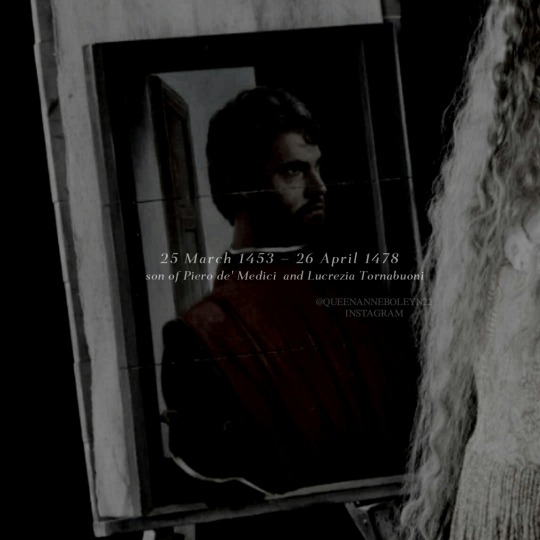
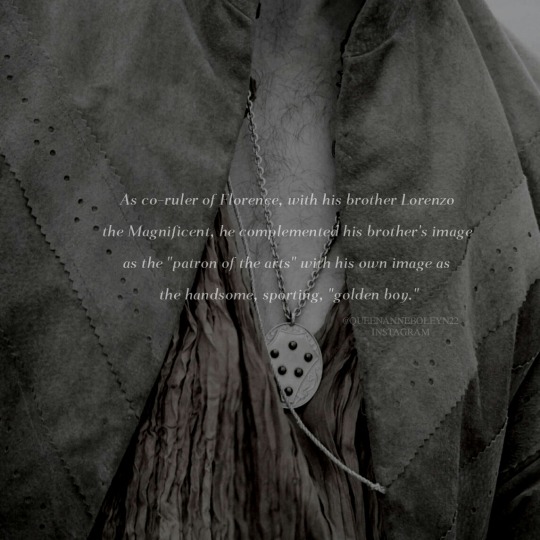



On this day in history,Giuliano de' Medici died during the Pazzi Conspiracy also know as #lacongiuradeipazzi
Giuliano , "The golden sporty boy", and great adviser of his brother Lorenzo didn’t get a chance to show all his qualities to the world, as he was brutally murdered during what is known as the Pazzi Conspiracy, on April 1478.
Poliziano captured something of the Medici family atmosphere after Giuliano's death in a letter to Lorenzo:
"The rain is so heavy and so continuous that we cannot leave the house and have exchanged hunting for playing at ball,so that the children should exercise. Our stakes are generally the soup,the sweet or the meat;and he who loses goes without; often when one of my scholars loses he pays tribute to Sir Humid [A popular italian euphenism for when a child cries]. I have no other news to give to you. I remain in the house by the fireside in slipers and a greatcoat;were you to see me you would think I was melancholy personified "
#giuliano de medici#i medici#mediciedit#tom bateman#on this day in history#history#historical#italian renaissance#renaissance italy#renaissance#lorenzo the medici#lorenzo the magnificent#il magnifico#my poor baby#renaissance men#a study#fioretta x giuliano#fioretta gorini#francesco pazzi#jacopo de pazzi#pazzi conspiracy#congiura dei pazzi#florence#firenze
111 notes
·
View notes
Note
Coerenza portami via, mo il problema sono Clarice e Lorenzo quando hanno romanzato altre ship più di loro. La differenza è che le altre le romanzano sempre così e credete sia verità ma 1) la Donati non era la sua amante. Amore platonico della giovinezza e stop, finita nell'ombra dopo il matrimonio. Lui non ebbe amanti se non dopo la morte di Clarice (una certa Bartolomea Nasi) 2) il vero amore di Giuliano era Fioretta Gorini da cui ebbe un figlio 3) l'amata coppia Francesco e Novella è inventata
In realtà, se leggi altri post che ho scritto sui Medici mi sono lamentata di TUTTE le storie d'amore romanzate della serie, non solo di questa.
Per dire.
Mi è venuta in mente questa, solo perché mi è capitata davanti un immagine oggi di questa coppia.
Edit: inoltre perdonami, ma stavo rileggendo il tuo commento: dove è che avrei scritto che Lucrezia Donati è amante di Lorenzo? Io ho scritto che le scrive sonetti d’amore.
0 notes
Text
The Girl Who Knew Da Vinci
The Girl Who Knew Da Vinci
From my review on OnlineBookClub:
…in the present day, aspiring curator Angela Renatus finds herself dreaming about da Vinci every night. This isn’t an art lover dreaming about the master, instead she has a recurring dream where she takes on the role of Fioretta Gorini, a good friend of Leonardo da Vinci and the girlfriend of Giuliano Medici. In her dreams, she discovers a painting that doesn’t’…
View On WordPress
0 notes
Text
El Cuadro de Botticelli
Este es el 3 post acerca de mi trabajo, hoy en la clase el profesor de artes dejo un vídeo acerca bottilcelli, pero hablaron de algo mas especifico, del cuadro de La Primavera de Sandro Botticelli es considerada una de las obras maestras del Renacimiento italiano, quien visita la Galería de los Oficios de Florencia se encanta frente a esta gran pintura: aunque el encanto del cuadro está tal vez ligado a la aura del misterio que gira en torno a la obra y cuyo significado más profundo no ha sido revelado completamente.
Por mis apuntes que tengo la obra más famosa de Sandro Botticelli, es del año 1482 aproximadamente, la escena en un bosque formado por árboles naranja y frutos, con un cielo azul de fondo, se disponen nueve personajes, en una composición que gira en torno al personaje central, una mujer con sábana roja, el suelo se compone por un prado formado por una gran variedad de vegetales y flores, la Primavera esconde varios niveles de lectura: uno estrictamente mitológico, cuya explicación es unánimemente compartida, uno filosófico, ligado principalmente a la filosofía de la academia neoplatónica; uno hist��rico-dinástico, ligado a las peripecias contemporáneas y a la gratificación del cliente y de su familia, el centro del cuadro se encuentra Venus, símbolo neoplatónico del amor más elevado, que observa toda la escena, sobre ella vuela su hijo Cupido, a su izquierda se encuentran las tres Gracias que están bailando, aún más a la izquierda se nota Mercurio, el mensajero de los dioses, representado con las alas en los pies, que con el caduceo alejaba las nubes para tener una eterna primavera, en cuanto a la interpretación filosófica, el primer crítico que puso el cuedro directamente en relación con el círculo de filosóficos neoplatónicos frequentada por Botticelli fue Aby Warburg en 1893, quien leía la Primavera como la representación de Venus después del nacimiento, durante la llegada a su reino. Segundo fue Ernst Gombrich en la Primavera se narraría como el amor, en sus diversos grados, llega a despegar al hombre del mundo trerrenal para llevarlo al espiritual: Zefiro y Clori representarían la fuerza del amor sensual e irracional, que es fuente de vida y, tramite la mediación de Venus y Cupido, se transforma en algo más perfecto, para después emprender el vuelo hacia las esferas celestes guiado por Mercurio.Según algunas lecturas de las obras ligadas al cliente, los personajes mitológicos de la pintura serian las representaciones de personajes fiorentinos e de sus virtudes, como en un desfile de carnaval. ya que parece que la obra fue inicialmente comisionada a Botticelli por Giuliano de’ Medici en ocasión del nacimiento de su hijo Giulio, nacido de Fioretta Gorini con quien se había casado en gran secreto en 1478. Pero Giuliano falleció en la Conspiración de los Pazzi tramada contra su hermano en el mismo año, un mes antes del nacimiento de su hijo, por lo que el cuadro, aún sin terminar, fue “reciclado” por el primo Pierfrancesco de’ Medici tiempo después para celebrar sus bodas, insertando su retrato y el de su esposa Semiramide Appiani, de quien se decía tener una belleza extrema, tuve que investigar mas a fondo acerca de la historia ya que me había quedado confuso acerca de esto, pero en fin esto es la primavera (algo que me sorprendio fue la mezcla de huevo, ya que no sabia acerca ese tipo de mezcla)
0 notes
Text
Everyone: i love giuliano and simonetta, she was his tRuE lOvE
Me, an intellectual: GIVE ME GIULIANO AND FIORETTA AND GIULIO BITCH

57 notes
·
View notes
Text

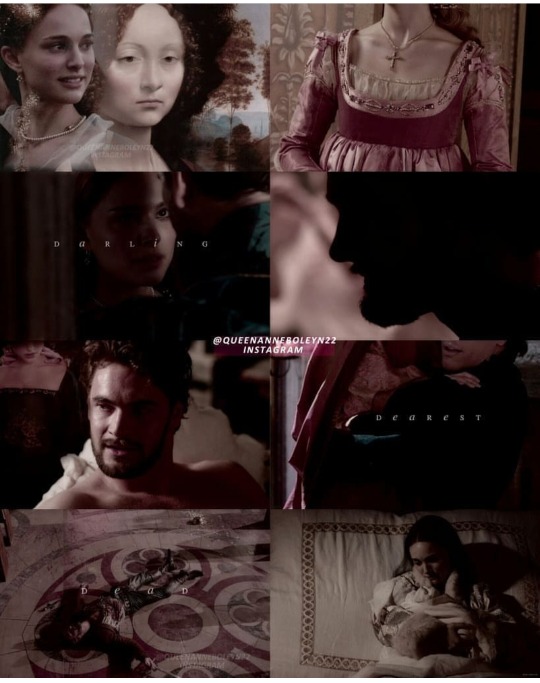
❀🄵🄸🄾🅁🄴🅃🅃🄰 🄶🄾🅁🄸🄽🄸
❈ Fioretta Gorini, a forgotten yet important figure of the Italian Renaissance was the daughter of professor Antonio Gorini and mistress of Giuliano de Medici, to whom she bore his illegitimate son Giulio, the future Pope Clement VII . The most intresting fact about their love story is that Giulio was born on the same day his father died in tragic circumstances during the Pazzi conspiracy.
❈ It seems that Fioretta was just a nickname while her real name was Antonia or Antoinetta. ❈Judging by some sources she was "the true love of Giuliano de Medici " , the woman who had stollen his heart and not Simonetta Vespucci.
❈ She was also the muse of some important artists of that time like Andrea del Verrocchio (the bust of the widow of Giuliano de Medici " - sculpted on Dama col mazzolino -1475), Leonardo da Vinci ( Ginevra de Benci) and Sandro Botticelli ( Ritratto di giovane donna-1475) .
❈Some historians are calling her "the widow of Giuliano de Medici " Therefore I will go further with this and name Fioretta the wife of Giuliano since he secretly married her before his assassination .
And here is the proof : 《" In 1513 some monks and the brother of Fioretta Gorini confirmed the clandestine marriage of the latter with Giuliano de' Medici. Their marriage was recorded in the Regest Leonis X. (n. 4598) for all times. (in: J. Nardi, Le storie della città di Firenze, Firenze 1684, p. 274). "When, in the autumn [1513], there was a question of his [Giulio de' Medici] being made a Cardinal, it was attested by witnesses that a valid marriage had taken place secretly between his father and mother, Floreta, a special deed to that effect being drawn up [Regest. Leonis X., n. 4598] "》
[Source: kleio.org © Maike Vogt-Lüerssen 1999 – 2019]
Dt: @ilmur
#fioretta gorini#i medici#giuliano de medici#fioretta and giuliano#natalie portman#tom bateman#history#history edit#house of medici#lorenzo the magnificent
41 notes
·
View notes